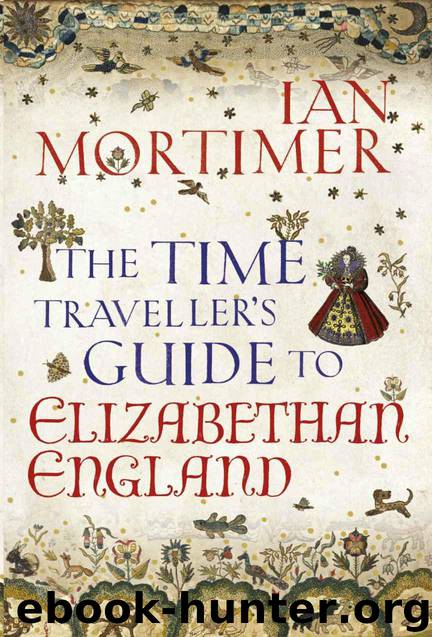The Time Traveller's Guide to Elizabethan England by Mortimer Ian

Author:Mortimer, Ian [Mortimer, Ian]
Language: eng
Format: mobi, epub
ISBN: 9781409029564
Publisher: Random House
Published: 2012-03-01T00:00:00+00:00
poultry (8s)
nineteen acres of wheat (£27 10s)
three horses (£6 10s)
four acres of rye (£5)
six pigs (£2 13s 4d)
thirty-two acres of barley (£32)
eight cows (£16)
fourteen acres of oats (£10)
three bullocks (£4)
ten acres of tares (£5)
150 sheep (£37 10s)
four acres of peas (£2 13s 4d)
twenty lambs (£3)
1½ acres of beans (£1 5s)
All that comes to £153 9s 8d. If you add the value of the lease of his farm (£10) and wool, malt and other stored farm produce (more than £30), you can see that he too has little wealth in his domestic furnishings. His house has no glass. A newly added chamber above the hall is given over entirely to storing wool, corn, malt and linen. His only luxuries are the featherbeds he has in his hall and inner chamber.30
You probably realise that the idea of a pleasure garden is incompatible with yeomen’s priorities: they seek comfort in their self-sufficiency, not in luxuries. Outside Jefferie Smith’s house is a range of outbuildings: a boulting house (for sifting flour), a kitchen with a storage loft above it, a milk house, two cart houses, a storehouse, a barn and a gatehouse, with a well in it. The privy is at the bottom of the plot, far away from the house, and you will have to go there each time you feel the call of nature; there are no chamber pots or close stools. The garden here is a place for herbs, vegetables, fruit and nut trees, the storage of lumber and occasionally bee keeping; if you see any flowers, they are self-seeded or planted for use in medicines. It is a far cry from the sculpted gardens at Theobalds and Hampton Court. But William Walter’s and Jefferie Smith’s houses both have something in common with the stately homes described above: they are the homes of ‘the haves’. There are many more people to be classed among the ‘have-nots’, who are starving on the roads or who are sleeping in servants’ rooms and rising at dawn to light the kitchen fire.
WORKERS’ HOUSES
Writing in the 1580s, Richard Carew describes old husbandmen’s cottages in Cornwall as having
walls of earth [cob], low thatched roofs, few partitions, no planchings [ceilings] or glass windows and scarcely any chimneys other than a hole in the wall to let out the smoke; their bed, straw and a blanket; as for sheets, so much linen cloth had not stepped over the narrow channel between them and [England]. To conclude, a mazer and a drinking cup and a pan or two comprised all their substance: but now most of these fashions are universally banished, and the Cornish husbandman conformeth himself with a better supplied civility to the Eastern pattern.31
Has the lot of the husbandman really improved, as Carew suggests? Are William Harrison’s three lifestyle improvements – chimneys, bedding and pewter – true for husbandmen and labourers too?
The richest husbandmen have certainly seen improvements to their lifestyle since the reign of Henry VIII. For example, Ralph Newbury, husbandman of Cropredy (Oxfordshire), has chattels worth £166 when he dies in 1578.
Download
The Time Traveller's Guide to Elizabethan England by Mortimer Ian.epub
This site does not store any files on its server. We only index and link to content provided by other sites. Please contact the content providers to delete copyright contents if any and email us, we'll remove relevant links or contents immediately.
| Archaeology | Essays |
| Historical Geography | Historical Maps |
| Historiography | Reference |
| Study & Teaching |
Underground: A Human History of the Worlds Beneath Our Feet by Will Hunt(12024)
Sapiens by Yuval Noah Harari(5294)
Navigation and Map Reading by K Andrew(5111)
The Sympathizer by Viet Thanh Nguyen(4305)
Barron's AP Biology by Goldberg M.S. Deborah T(4098)
5 Steps to a 5 AP U.S. History, 2010-2011 Edition (5 Steps to a 5 on the Advanced Placement Examinations Series) by Armstrong Stephen(3689)
Three Women by Lisa Taddeo(3354)
Water by Ian Miller(3128)
The Comedians: Drunks, Thieves, Scoundrels, and the History of American Comedy by Nesteroff Kliph(3039)
Drugs Unlimited by Mike Power(2545)
A Short History of Drunkenness by Forsyth Mark(2233)
DarkMarket by Misha Glenny(2159)
The House of Government by Slezkine Yuri(2159)
And the Band Played On by Randy Shilts(2129)
The Library Book by Susan Orlean(2042)
Revived (Cat Patrick) by Cat Patrick(1963)
The Woman Who Smashed Codes by Jason Fagone(1929)
Birth by Tina Cassidy(1864)
The Absolutely True Diary of a Part-Time Indian by Sherman Alexie(1858)
